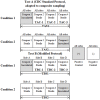Composite sampling of a Bacillus anthracis surrogate with cellulose sponge surface samplers from a nonporous surface
- PMID: 25470365
- PMCID: PMC4254944
- DOI: 10.1371/journal.pone.0114082
Composite sampling of a Bacillus anthracis surrogate with cellulose sponge surface samplers from a nonporous surface
Abstract
A series of experiments was conducted to explore the utility of composite-based collection of surface samples for the detection of a Bacillus anthracis surrogate using cellulose sponge samplers on a nonporous stainless steel surface. Two composite-based collection approaches were evaluated over a surface area of 3716 cm2 (four separate 929 cm2 areas), larger than the 645 cm2 prescribed by the standard Centers for Disease Control (CDC) and Prevention cellulose sponge sampling protocol for use on nonporous surfaces. The CDC method was also compared to a modified protocol where only one surface of the sponge sampler was used for each of the four areas composited. Differences in collection efficiency compared to positive controls and the potential for contaminant transfer for each protocol were assessed. The impact of the loss of wetting buffer from the sponge sampler onto additional surface areas sampled was evaluated. Statistical tests of the results using ANOVA indicate that the collection of composite samples using the modified sampling protocol is comparable to the collection of composite samples using the standard CDC protocol (p = 0.261). Most of the surface-bound spores are collected on the first sampling pass, suggesting that multiple passes with the sponge sampler over the same surface may be unnecessary. The effect of moisture loss from the sponge sampler on collection efficiency was not significant (p = 0.720) for both methods. Contaminant transfer occurs with both sampling protocols, but the magnitude of transfer is significantly greater when using the standard protocol than when the modified protocol is used (p<0.001). The results of this study suggest that composite surface sampling, by either method presented here, could successfully be used to increase the surface area sampled per sponge sampler, resulting in reduced sampling times in the field and decreased laboratory processing cost and turn-around times.
Conflict of interest statement
Figures






References
-
- EPA (2013) Systematic evaluation of aggressive air sampling for Bacillus anthracis spores: Assessment and evaluation report. Research Triangle Park, NC: U.S. Environmental Protection Agency. EPA 600/R-13/068 EPA 600/R-13/068.
-
- Lee SD, Calfee MW, Mickelsen L, Wolfe S, Griffin J, et al. (2013) Evaluation of surface sampling for Bacillus spores using commercially available cleaning robots. Environmental Science & Technology 47:2595–2601. - PubMed
-
- Patil GP, Gore SD, Taillie C (2010) Composite sampling: a novel method to accomplish observational economy in environmental studies: Springer.
-
- Johnson GD, Patil GP (2001) Cost analysis of composite sampling for classification. Environmental and Ecological Statistics 8:91–107.
Publication types
MeSH terms
Substances
LinkOut - more resources
Full Text Sources
Other Literature Sources

